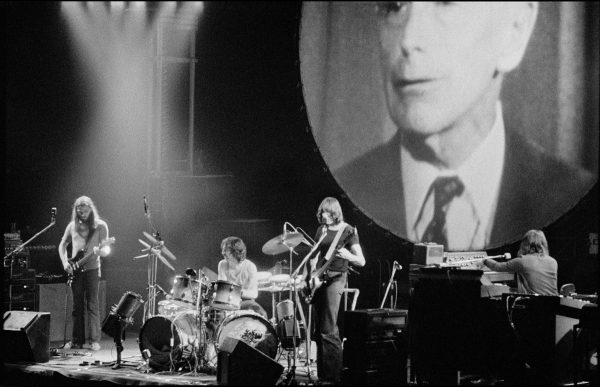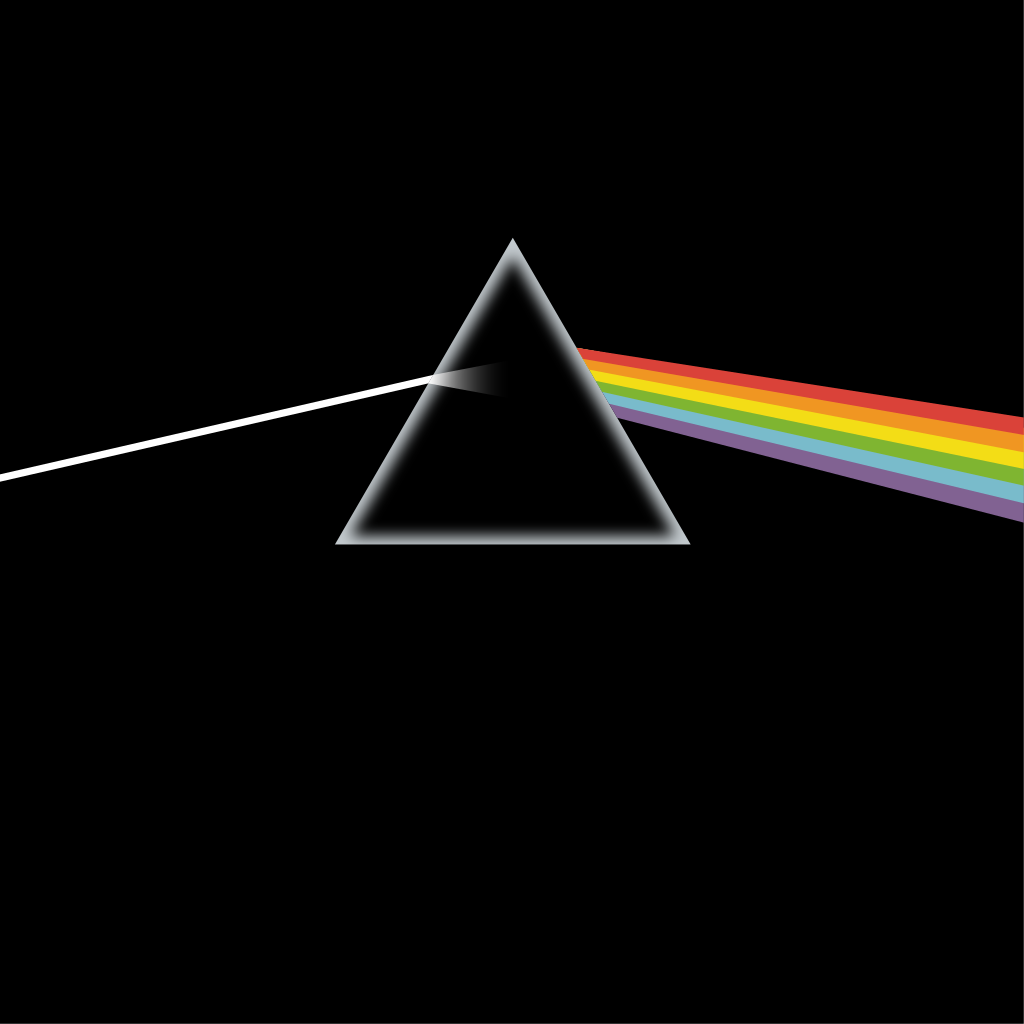Few albums have the status “The Dark Side of the Moon” has. Even if someone hasn’t listened to the album, I guarantee most people recognize the light prism on the cover.
“The Dark Side of the Moon,” released March 1, 1973, is the eighth studio album released by progressive rock band Pink Floyd. The album is designed as a continuous song and explores multiple concepts, including anger, greed, time, death and mental illness.
This year is the 50th anniversary of the release of the album. Since then, it has grown to be one of the most celebrated and acclaimed albums of all time and a benchmark in music history.
The introductory song, “Speak to Me,” begins with a heartbeat that sounds almost like a drum. Later in the track, we hear sounds of cash registers, change and ripping paper, followed by a monologue about the unexplainable anger that comes along with the stresses of work and money. It’s a simple but effective opener to the album that hints at later songs.
“Speak to Me” flows into the next song, “Breathe (In the Air).” The song starts with a painful, almost haunting scream, which cascades into the opening bass line. David Gilmour, guitarist and vocalist, sings this song with calm and relaxed vocals. The song is about the melancholic view of life as a limited experience that most people don’t fully appreciate. While life is full of disappointment and failure, there is a certain beauty to it that, if you hold yourself back, you will never experience.
This theme continues in the instrumental song “On the Run.” It is entirely composed of wacky and obtuse synths, guitars and sound bites. The song is open to interpretation, as it’s not clear what it’s about. However, as “On the Run” has airplane terminal sound effects, it could be an extension of the previous song. This time, it’s about accepting death and letting go.

The next song, “Time,” begins with a series of alarms and bells playing loudly over each other. The introduction almost makes you shy away from listening further, but soon after this, the beat is brought in, and we are pulled into the same synth as we see in “On the Run.” The song focuses on the passage of time. Not every waking moment of one’s life is going to be “exciting.” Sometimes, we feel like we are just waiting for time to pass us by, but when we look back on those moments, we wish we had done more with our time.
The most unique song on the album is “The Great Gig in the Sky.” The introduction of the song is a spoken word segment about the fear of death. After this comes a sequence where Clare Torry begins singing. No words are spoken. Instead, it’s this gospel where she sings as if she is screaming. It’s beautiful and haunting as it represents the fear of death, as discussed at the beginning of the song.
The most popular song on the album, “Money,” is about the paradox of money. While it is futile and unnecessary for the “human experience,” money still holds an incredible value. It is 100% necessary for sustaining life. The instrumentation is the major standout part of the song, with an excellent bass line, a saxophone lick performed by Dick Perry and one of Gilmour’s best guitar solos.
The next song, “Us and Them,” is criminally underrated. The reintroduction of the saxophone makes this song blend so well with “Money.” This song battles the senseless nature of war and how it feels like the common people don’t get a say in the brutalities of war. The song separates “Us and Them,” with “us” being those affected by a war not wanted, and “them” being those who start the wars and don’t suffer the consequences. “Us and Them’s” soft tone juxtaposes with its vocal depictions of bloodshed.
“Any Color You Like” is another instrumental. Unlike the previous instrumentals, it’s much more psychedelic. While the meaning of it isn’t quite clear, the song has such a good vibe that it doesn’t need a meaning.

The penultimate song on the album, “Brain Damage,” transitions via a guitar solo. This song is about falling into insanity and the denial that comes with it at times. The opening lyric, “the lunatic,” is a reference to insanity and how it is near, but denying its importance mirrors how many people deal with mental illness. By the time that “the lunatic” is in your head, it is too late.
The album closes with “Brain Damage” fading into “Eclipse.” This song is a reflection of the album, going over all actions and apparent contractions in life disappearing at the point of death, hinted at in the last line of the song, “but the sun is eclipsed by the moon.”
The album fades out with a heartbeat and a beat of a drum, the same one present at the beginning of the album.
“The Dark Side of the Moon” has stood the test of time. Comparing this album to other modern rock records, it sounds just as good, if not better, than records made with modern technology. It is a testament to all of the band members working on it.
As excellent and monumental as this album is, every masterpiece has its cheap knockoff. With “The Dark Side of the Moon,” it’s Roger Waters’ “The Dark Side of the Moon Redux.”
“The Dark Side of the Moon Redux:”
“The Dark Side of the Moon Redux,” released Oct. 6, is the seventh studio album released by former bassist and vocalist of Pink Floyd, Roger Waters. The album is a re-release of the original album for the 50th anniversary.
This version has a completely different tone and vibe compared to the original. While a new interpretation can be interesting, Waters’ interpretation completely misses the mark on why the original was so great.
The biggest example would be Waters’ vocals. While there are some examples of singing on the album, for the most part, they are replaced with weird, boring spoken word segments. It completely removes the emotion and tone of the original music and makes it boring.
For example, in “Time,” where the song starts with a new segment where he just mumbles jargon. It’s what people who don’t like poetry think poetry sounds like. It’s overblown and dull. It’s baffling, especially on one of the more exciting songs on the album. It leaves me wanting more, which is a weird problem to have with a Pink Floyd album.

Another aspect that left the listener wanting more is the instrumentals or lack thereof. It’s the equivalent of a live, unplugged album. Usually, unplugged albums add some depth to the music. Here, it waters it down and makes it very boring.
“Money” on the original album is a song with a bunch of different instrumentals and sounds, giving it a lot of depth to the song. On the redux, it’s just an acoustic, slowed-down version with no life in it. This song especially stands out because it’s practically unlistenable with how much life is taken out of it.
This brings us to the biggest reason why this album is so bad: what it stands for.
Waters is one of the most important minds in music. His contributions to music paved the way for a new age of rock music and a different way of thinking about music. However, he was not alone in composing the music.
At least nine people appeared on the original album, and most of them had different contributions. Richard Wright’s organ, synth, vocals and piano parts. David Gilmour’s guitar and vocals. Nick Mason’s subtle yet effective drumming and percussion. The parts that made the whole are much more important than people realize.

“The Dark Side of the Moon Redux” is an ego trip of an album in which Waters’ tries to attribute the success of the album to him and him alone, which cannot be further from the truth.
Pink Floyd is so beloved because all its members worked together in unison on a specific, realized idea and executed it using the full ability of their skills. Without all of the members present and their contributions, the music falls flat.
That is why “The Dark Side of the Moon” is cherished as it is, and “The Dark Side of the Moon Redux” is so awful.







